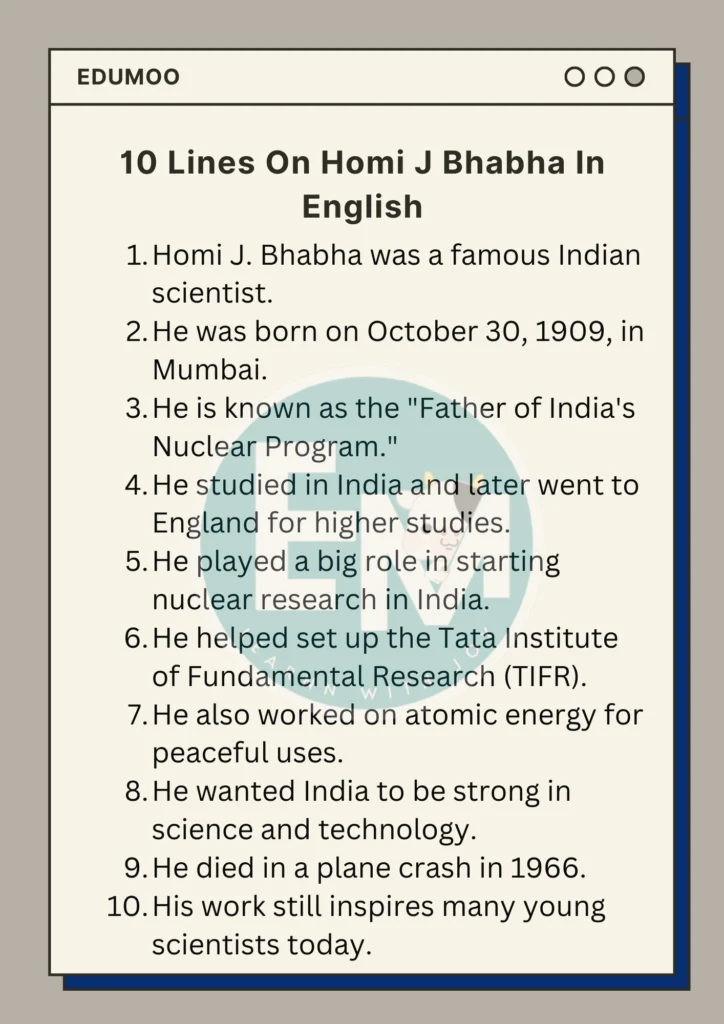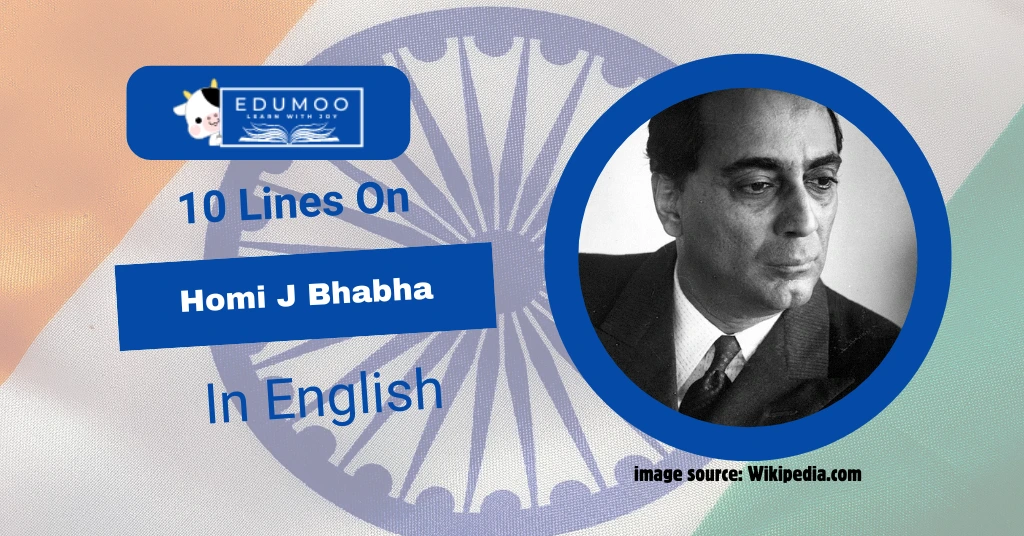Homi J. Bhabha was a brilliant scientist who changed India’s future. He played a big role in starting nuclear science in the country. He worked hard to make India a leader in atomic energy. His research and ideas helped India grow in science and technology. He started the Tata Institute of Fundamental Research to support young scientists. He also believed in using atomic energy for peace. His contributions are very important for India. He is remembered as the “Father of India’s Nuclear Program.” His work still inspires many young minds. Let’s learn 10 lines on Homi J Bhabha.
10 Lines On Homi J Bhabha In English
- Homi J. Bhabha was a famous Indian scientist.
- He was born on October 30, 1909, in Mumbai.
- He is known as the “Father of India’s Nuclear Program.”
- He studied in India and later went to England for higher studies.
- He played a big role in starting nuclear research in India.
- He helped set up the Tata Institute of Fundamental Research (TIFR).
- He also worked on atomic energy for peaceful uses.
- He wanted India to be strong in science and technology.
- He died in a plane crash in 1966.
- His work still inspires many young scientists today.

Essay On Homi J Bhabha In English In 250 Words
Homi J. Bhabha was a great Indian scientist who is known as the “Father of India’s Nuclear Program.” He was born on October 30, 1909, in Mumbai. He was very intelligent and loved science from a young age. He completed his studies in India and later went to England to study physics. He was very interested in atomic energy and its uses.
After returning to India, Bhabha wanted to develop nuclear science in the country. He started the Tata Institute of Fundamental Research (TIFR) in 1945. This institute helped young scientists learn and research nuclear energy. He also played a major role in setting up the Atomic Energy Commission of India. His goal was to use atomic energy for peaceful purposes, such as producing electricity.
Bhabha’s hard work and dedication made India strong in science and technology. He wanted India to become independent in nuclear research. Under his guidance, India made great progress in atomic energy. He believed that science could help the country grow and improve people’s lives.
Unfortunately, Homi J. Bhabha died in a plane crash on January 24, 1966. His sudden death was a great loss for India. However, his contributions to science and technology remain important. His research and ideas continue to inspire scientists today. Because of his efforts, India became a leader in nuclear energy.
Homi J. Bhabha was a visionary who dreamed of a strong and self-reliant India. His work in nuclear science changed the future of the country. He is remembered as a great scientist and a true patriot. His legacy continues to guide India in scientific research and development.
Essay On Homi J Bhabha In English In 550 Words
Homi Jehangir Bhabha, born on October 30, 1909, in Bombay (now Mumbai), India, was a pioneering Indian nuclear physicist. He is often referred to as the “Father of India’s Nuclear Program” due to his significant contributions to the country’s atomic energy sector. Bhabha hailed from a prominent Parsi family; his father, Jehangir Hormusji Bhabha, was a well-known lawyer, and his mother, Meherbai, was the granddaughter of Sir Dinshaw Maneckji Petit, a notable industrialist. From a young age, Bhabha exhibited a keen interest in science and the arts, showcasing talents in both physics and painting.
In 1927, Bhabha traveled to England to pursue higher education at the University of Cambridge. Initially, he aimed to study mechanical engineering to satisfy his family’s wishes. However, his passion for physics led him to switch his focus, and he earned a degree in mathematics and physics. During his time at Cambridge, Bhabha conducted research under prominent scientists and made significant contributions to the understanding of cosmic rays. His work earned him recognition in the scientific community, and he was awarded the prestigious Adams Prize in 1942.
The outbreak of World War II in 1939 prompted Bhabha to return to India. He accepted a position at the Indian Institute of Science in Bangalore, working alongside Nobel laureate C.V. Raman. Recognizing the need for a dedicated research institution in India, Bhabha advocated for and established the Tata Institute of Fundamental Research (TIFR) in Mumbai in 1945. This institute became the cradle for India’s scientific research and development, particularly in nuclear science.
Bhabha’s vision extended beyond pure research; he was instrumental in setting up the Atomic Energy Commission of India in 1948, aiming to harness nuclear energy for peaceful purposes. Under his leadership, India embarked on a journey to develop nuclear power, focusing on self-reliance and indigenous capabilities. He believed that atomic energy could play a pivotal role in addressing India’s energy needs and spearheading technological advancement.
Apart from his scientific endeavors, Bhabha had a profound appreciation for the arts. He was an accomplished painter and had a deep love for classical music. His multifaceted personality made him a true Renaissance man, seamlessly blending science and art. Bhabha’s leadership style was characterized by his ability to inspire and mentor young scientists, fostering a culture of innovation and excellence at institutions like TIFR.
Tragically, Homi J. Bhabha’s life was cut short when he died in a plane crash on January 24, 1966, near Mont Blanc in France. His untimely demise was a significant loss to the nation. In his honor, the Atomic Energy Establishment in Trombay was renamed the Bhabha Atomic Research Centre (BARC), serving as a testament to his enduring legacy in India’s nuclear journey.
Bhabha’s contributions laid the foundation for India’s advancements in nuclear science and technology. His visionary leadership not only propelled India onto the global nuclear map but also inspired generations of scientists to pursue research with dedication and integrity. Today, institutions like TIFR and BARC continue to thrive, embodying Bhabha’s dream of a self-reliant and scientifically advanced India.
In conclusion, Homi J. Bhabha was a luminary whose life’s work bridged the realms of science and art. His relentless pursuit of knowledge and his commitment to national development have left an indelible mark on India’s scientific landscape. As we reflect on his legacy, we are reminded of the power of vision, passion, and dedication in shaping a nation’s destiny.
Conclusion
Today, we have learnt 10 lines on Homi J Bhabha in English. Homi J. Bhabha was a great scientist who helped India progress in science. His ideas on nuclear energy changed the country’s future. He worked hard to make India a strong nation in science and technology. Even after his death, his contributions remain important. Many scientists today follow his path. His research and dedication made India proud. Because of him, India made great progress in nuclear energy. We should always remember his work and learn from him. Homi J. Bhabha will always be an inspiration for young scientists.

